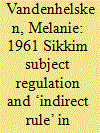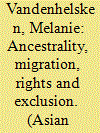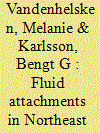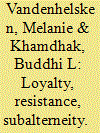|
|
|
Sort Order |
|
|
|
Items / Page
|
|
|
|
|
|
|
| Srl | Item |
| 1 |
ID:
177553


|
|
|
|
|
| Summary/Abstract |
This paper discusses the principles behind the 1961 Sikkim Subject Regulation, the first citizenship law framed in Sikkim. It explores the historical construction of the entanglement of ‘ancestrality’ with land property and political membership, which is central to the issue of citizenship in Sikkim today. It shows how categories of citizens were formed in colonial and post-colonial time, in particular the division between ‘natives’ (Bhutia and Lepcha) and ‘settlers’ (Sikkimese Nepalis). With the revision of the Regulation in 1962, land property and ‘ancestral’ settlement became central criteria to acquire Sikkim Subject status. The paper shows how land property have become a materialisation of belonging to the place, and highlights the inequalities that the dependency created between insidedness and land property engendered. It also argues that a sole analysis of these inequalities in terms of ethnicity is insufficient by showing that other factors have taken part in forming them.
|
|
|
|
|
|
|
|
|
|
|
|
|
|
|
|
| 2 |
ID:
177551


|
|
|
|
|
| Summary/Abstract |
This is the introduction to a special issue of Asian Ethnicity that includes six papers on the issue of citizenship in the Indian state of Sikkim, from the perspectives of anthropology, political science, sociology and history. These contributions explore the entanglement of migration and ethnicity that defines political membership and exclusion in Sikkim, as it does in other parts of India. They give a central place to the consequences of the combination of the 1961 Sikkim Subject regulation (that remained valid after Sikkim became a part of India in 1975) and ‘group-differentiated citizenship’ in a context where Sikkim’s population – formed through people’s mobility within a region that has long been a crossroads between Nepal, Tibet, Bhutan and India – was brought into the frame of a territorial concept of the nation. These papers also explore the means used by people in Sikkim to contest their categorisation by the state.
|
|
|
|
|
|
|
|
|
|
|
|
|
|
|
|
| 3 |
ID:
144686


|
|
|
|
|
| Summary/Abstract |
This introduction presents the context and theoretical basis of fluidity of attachments in Northeast India. A large cultural, linguistic, and ethnic diversity, an international border situation, and various forms of unsettled relations with ‘mainstream India’ characterize Northeast India. These aspects form the frame of highly dynamic movements of identity and ethnicity formation. This special issue includes five papers that focus on these dynamics in terms of ‘fluidity’; they present new situations of shift between different layers of identification, re-signification of cultural practices in the process of their selection as emblems of groups‘ identity, changes in groups’ specific practices after religious conversion, and shifts from one identity to another. They show that shifts of ethnic identity are old processes in the region, whereas other levels of identification, such as lineages, clans, villages, and new ‘cosmopolitan’ identities coexist alongside ethnic identity, and gain particular salience in certain situations or points of time.
|
|
|
|
|
|
|
|
|
|
|
|
|
|
|
|
| 4 |
ID:
177552


|
|
|
|
|
| Summary/Abstract |
This paper explores the process of construction of the interconnection between ethnicity, indigeneity, and political participation in Sikkim concerning the Limbu ethnic community. It firstly discusses Limbu associations’ claims for the reservation of seats for the Limbu community in the state legislative assembly, following the recognition of the group as a Scheduled Tribe in 2003. From this point on, the paper goes further back in time, and, based on archival documents, shows that the view of the lack of political representation of the Limbu as a result of ethnic discrimination is grounded in a ‘uncertain’ membership, which has historical roots dating back to the foundation of the kingdom. It shows that the troubled relations between the Limbu and the leading power in Sikkim in the early days of the kingdom long continued to inform their subaltern form of political membership.
|
|
|
|
|
|
|
|
|
|
|
|
|
|
|
|
|
|
|
|
|